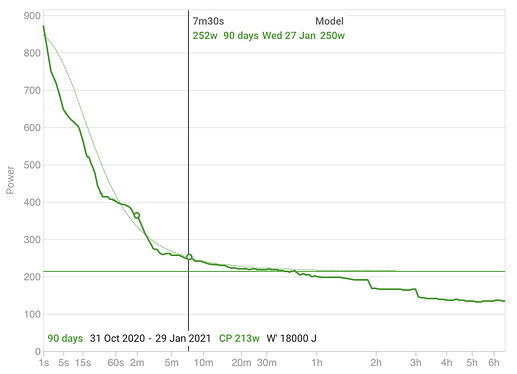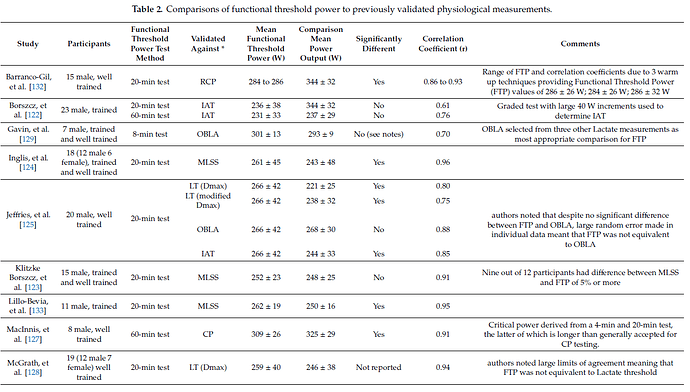Thanks for posting these, I found them very helpful and had fun digging down the rabbit hole. I’d just like to share some quick thoughts, after having experimented with this tool which is an implementation of several CP models and allows you to enter your own data. I found that it estimates my CP in the range of 285 to 325, which, you will agree, is quite a wide spread and not very useful for training. The same goes for W’, which was anywhere between 15 and 40kJ. Now, as I have had a power meter for 2 years now, I have a very good idea of where my CP is simply by looking at the log-log plot of my power curve, which has a distinct kink at around 20 minutes. Ultimately, this would be the model validation. The one idea I had was this: is it possible to implement a method of calculating W’ by integrating the are below the real power curve (not the model generated) and the line set by the athlete as FTP (which in this case has to be entered instead of CP)? Thus, we would have realistic values for the two parameters that matter and could start on solid ground.
Hi. I’m aware of Maturana’s tool and use it in testing and also wrote about it in an article on Critical Power (attached below for reading).
With a multi-duration single visit test, you can pop in 3-4 MMPs and throw them into the tool for a quick rundown of different models and the effect on CP,W’. The engineer in me looks at the different values and tries to understand which one would most resemble a point beyond which I start losing a lot of efficiency and drive myself towards VO2max. One way to validate is do a 20-25K TT at 100% commitment under controlled conditions every time you test. Then check TTE and validate the model.
An under-estimated CP has an over-estimated W’ and vice versa. Estimation differences are due to the particular choice of durations, so practitioners need to be aware of what durations can do to the parameters from modeling. I suggest the original paper from Maturana et.al on effect of protocol if you haven’t read it.
In my experience, given a good dataset and a power curve from test day and test durations with a decent spread between 3 and 20 minutes (such as 3,7 and 12 minutes), the CP 1/time model comes out as the simplest and best estimate of CP in terms of low RMSE. A bandwidth of 5-10W around a CP estimate is a requirement for practical and physiological reality.
Protocol dependency for models is different from physiological phenomenon. Its good to set our eyes on what’s happening in the body, otherwise we are simply drawing cartoons for ourselves and won’t be training at right intensities. Critical thinking is highly recommended.
The one idea I had was this: is it possible to implement a method of calculating W’ by integrating the are below the real power curve (not the model generated) and the line set by the athlete as FTP (which in this case has to be entered instead of CP)?
You can. You need to know TTE (time to exhaustion, read off power curve), power output and CP estimate and then its basic algebra. A pre-requisite for this would still be a quality power duration curve. You run into estimation errors with submaximal data. That’s the one challenge with Intervals.ICU, you never know what is the quality of people’s power curves. In Golden Cheetah, you have a rich feature set to clean up the curve and only dot it with MMPs from maximal efforts and/or performance testing.
Additional reading :
Critical power: How different protocols and models affect its determination
Critical Power Concept in Exercise : Critique and Applications
I probably need to expose “eCP” in the UI and also W’ calculated relative to CP and not FTP. Then people who would prefer to work with CP can just enter that instead of FTP.
Offering that flexibility would be great, and in the context of training in the correct areas based on a scientifically validated concept.
I do not have a background in modeling but really appreciate the detail and precision in this thread. Thank you for including articles for reference as well.
Very nice blog; thanks aligns almost completely with my view [here] which I just updated with a couple of your nice figures; with credit of course  (Is FTP physiologically real...or does it exist only in Coggan's imagination? - CyclingApps.net | Fastfitness.tips).
(Is FTP physiologically real...or does it exist only in Coggan's imagination? - CyclingApps.net | Fastfitness.tips).
Hi Alex I read that article of yours yesterday. I see a lot of criticism of FTP where it’s clear that the people criticising haven’t even read Coggan’s book (not suggesting that’s you BTW). There’s a good interview with Coggan here (can’t remember where I got the link, may have been one of your articles) where he makes it pretty clear that some people don’t understand how to interpret his work: Fast Talk, ep. 72: Do we need training zones? With Dr. Andy Coggan, Dr. Stephen McGregor, and Hunter Allen – VeloNews.com
Eg - If you are supposed be training in a ‘zone’ that is 200-240W, it really doesn’t matter if you drop to 190W or go up to 250W. Like your statement about 60m power - nothing special happens at 200W or 240W that suddenly invalidates the work you are doing.
I think people just need to understand their training goals - are you training ‘base’, threshold or VO2Max? Do an effort at an intensity and duration (and potentially intervals) appropriate to the thing you are trying to train.
I like how he explains that the levels/zones are really just to help people to train without having to understand physiology. Eg. “go and do a 3-4Hr effort at under 200W” for base training; “do some intervals at 300W” for VO2Max.
I have added an eCP version of eFTP to the power models for athletes who would prefer to work with CP instead of FTP:
Athletes using CP to set training zones and so on can just enter CP everywhere instead of FTP. When Intervals.icu says your eFTP has gone up, go to the /power page select “eCP” power model and 90 days and read your estimated CP and W’ off the chart legend:
Great work David. Thanks for taking some of the considerations of this thread into action.
Thanks I will check it out!
One’s personal liking of Dr. Coggan’s opinions does not refute the fact that FTP’s validity as either a performance measure, or a physiological proxy, is questionable at best.
Below are some of the tabulated references from doi:10.3390/sports8090123 for further reading :
Not sure you could say FTP is not valid as a performance measure. Is a 20min TT (or 60min, or 2x 8min) valid as a performance measure? Or are race results the only real performance measure? 
From what you’ve seen, do you have a sense of which protocol for determining FTP is most consistent with CP/MLSS/MPSS? eg. 60-min vs 5-min + 20-min TT vs 20-min TT vs… ugh… 8-min? Or are they all similarly inconsistent?
Or are they all similarly inconsistent?
All similarly inconsistent I would say. I stuck in this table about two posts above yours, so have a look. Gives a concise summary of current understanding. https://forum.intervals.icu/t/ftp-and-cp-interchangeability-some-notes/2665/16?u=coach_ron
More reading in the two links given in this thread :
http://www.georgeron.com/2020/04/functional-threshold-power-FTP-myths-facts.html
Bit of a tangential question, is there a graph of the model of the CP model for eFTP?
For example, if you have an eFTP, you would expect 3min power to be X, and 5min Y, etc
Just out of curiosity more than anything.
I find the eFTP tools to be useful reality checks.
There isn’t yet. It is probably something I should plot on the /power page.
Is it possible to set FTP and CP separately as different values?
My CP is usually 15-25 watts higher than FTP and using my FTP value together with my Wbal does not modell well. Since FTP is lower than CP I can push well below 0 for Wbal.
It can also bee seen in the rather unreasonable values estimated for W’. At 29 700 J and 67 kg i would be at 443 J/kg and that is sort of “off-the-charts” and would be absolute world class.
In fact my umbers are more like an CP of 345-350 and a W’ of 20-21 kJ. I can set W’ but since I can not set CP separate from FTP this model will fail me.

A workaround is to simply set FTP under power settings and within the ride settings as your CP value.
It works for me because I do not really care about the Coggan FTP. We know what CP is physiologically. We don’t know what is FTP.
As for unreasonable values from the model, I think this is where a sanity check comes in. Test the effect of different models, The math is different 2-P to Morton’s. If you have a knowledge of historical values you know to be true, select the model that best approaches those values. Use those numbers.
Yeah, I tend to review power zones in terms of FTP and W’ and matches etc in terms of CP, so I use both. But i can do that in GC anyay, just trying to cram as much as possible over to intervalls as it is a bit more convient.
Unfortunately when I started this I knew nothing about power modelling and the FTP people are good at SEO so thats all you read about when you Google. So Intervals.icu doesn’t have a separately tracked CP field and the workaround is to enter CP for your FTP and W’bal to match.



